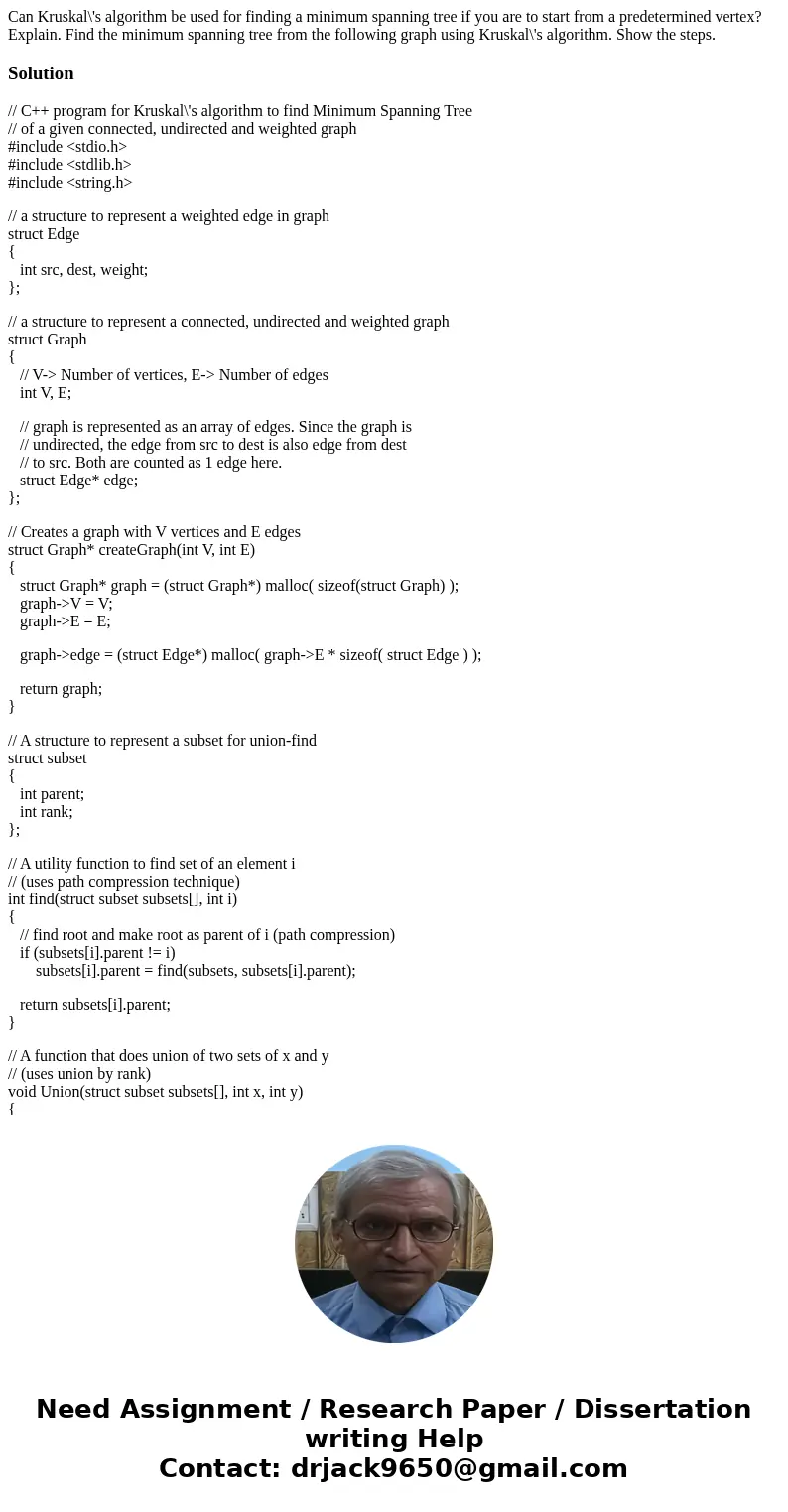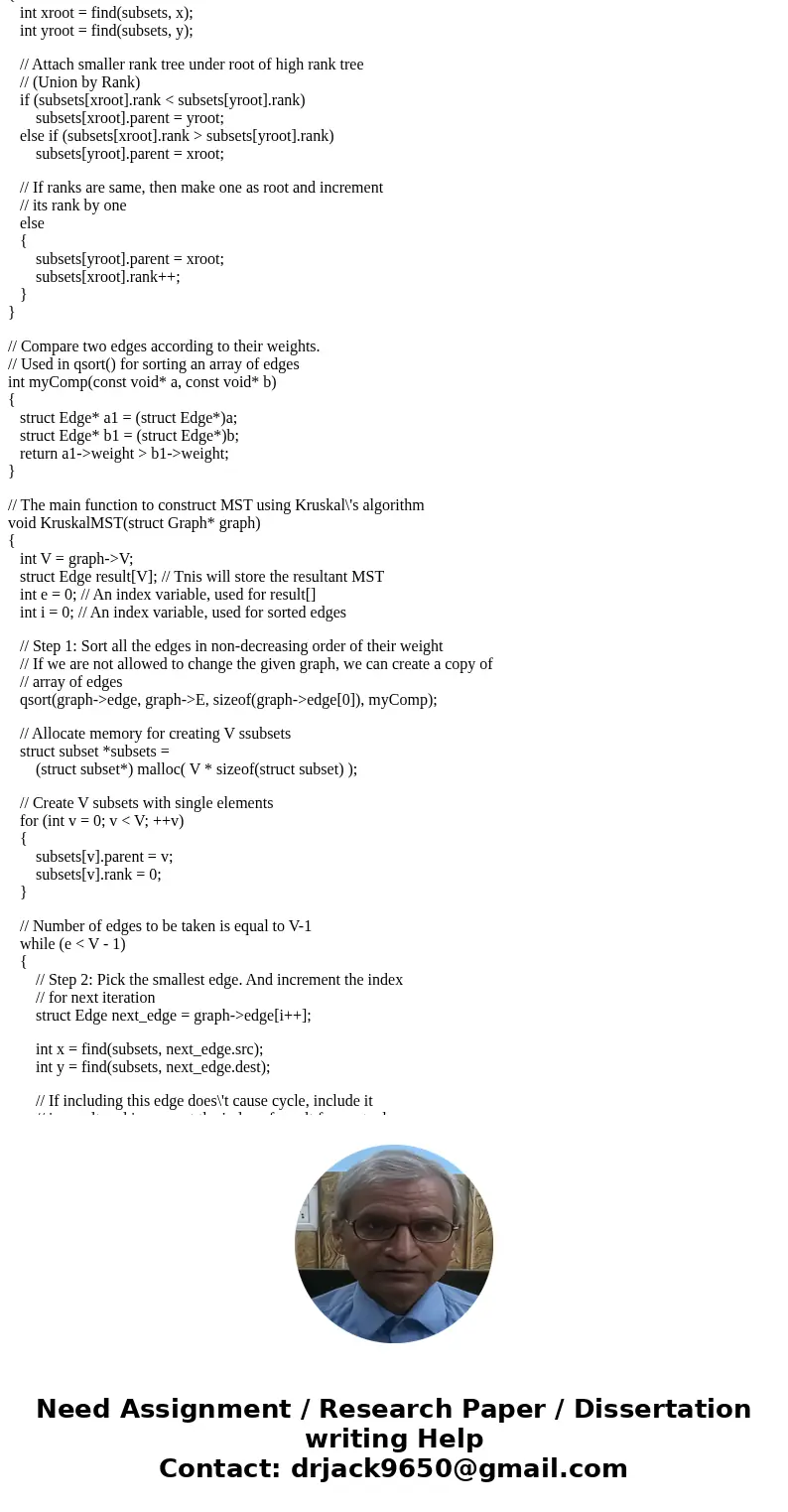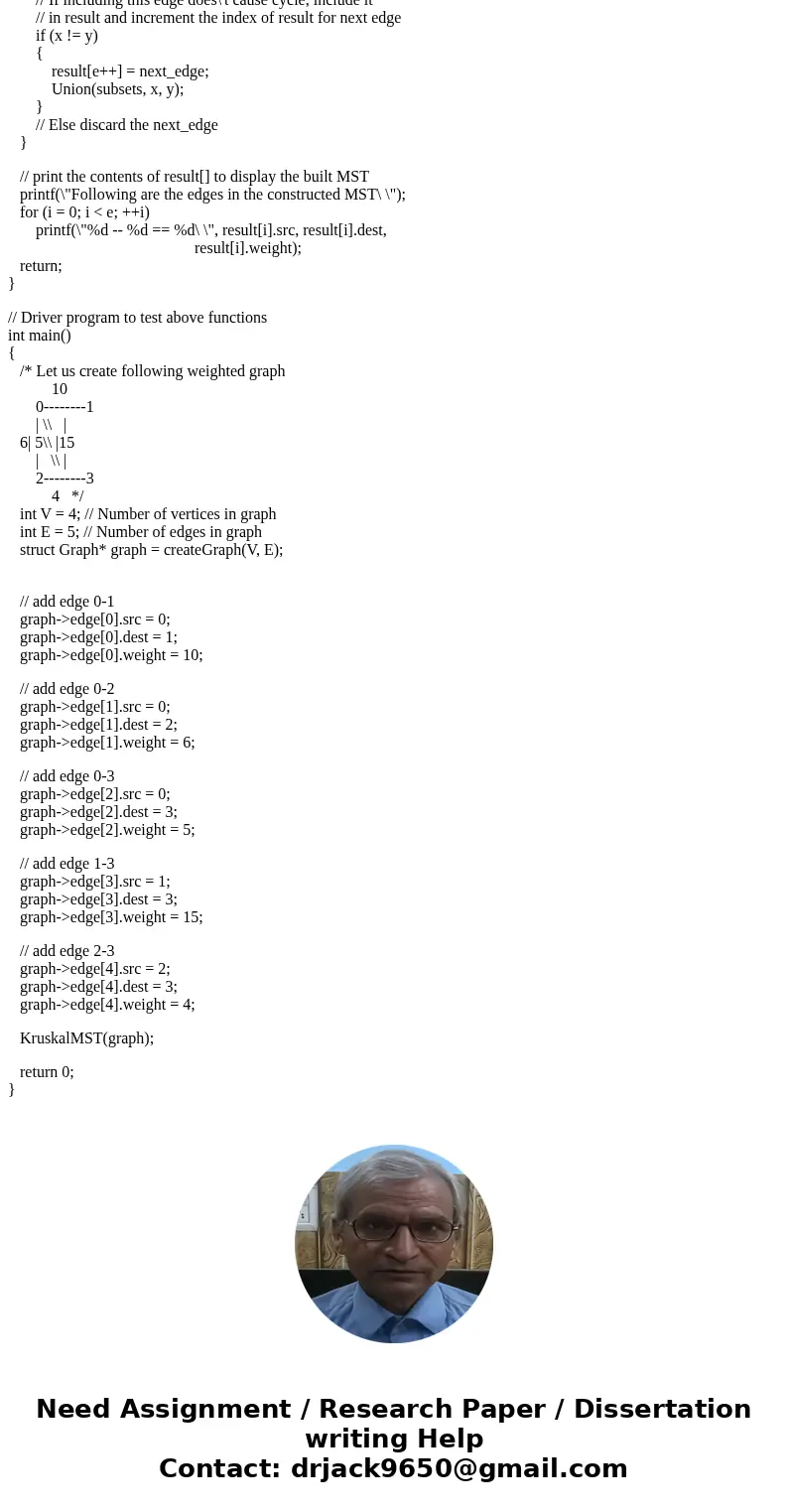Can Kruskals algorithm be used for finding a minimum spannin
Solution
// C++ program for Kruskal\'s algorithm to find Minimum Spanning Tree
// of a given connected, undirected and weighted graph
#include <stdio.h>
#include <stdlib.h>
#include <string.h>
// a structure to represent a weighted edge in graph
struct Edge
{
int src, dest, weight;
};
// a structure to represent a connected, undirected and weighted graph
struct Graph
{
// V-> Number of vertices, E-> Number of edges
int V, E;
// graph is represented as an array of edges. Since the graph is
// undirected, the edge from src to dest is also edge from dest
// to src. Both are counted as 1 edge here.
struct Edge* edge;
};
// Creates a graph with V vertices and E edges
struct Graph* createGraph(int V, int E)
{
struct Graph* graph = (struct Graph*) malloc( sizeof(struct Graph) );
graph->V = V;
graph->E = E;
graph->edge = (struct Edge*) malloc( graph->E * sizeof( struct Edge ) );
return graph;
}
// A structure to represent a subset for union-find
struct subset
{
int parent;
int rank;
};
// A utility function to find set of an element i
// (uses path compression technique)
int find(struct subset subsets[], int i)
{
// find root and make root as parent of i (path compression)
if (subsets[i].parent != i)
subsets[i].parent = find(subsets, subsets[i].parent);
return subsets[i].parent;
}
// A function that does union of two sets of x and y
// (uses union by rank)
void Union(struct subset subsets[], int x, int y)
{
int xroot = find(subsets, x);
int yroot = find(subsets, y);
// Attach smaller rank tree under root of high rank tree
// (Union by Rank)
if (subsets[xroot].rank < subsets[yroot].rank)
subsets[xroot].parent = yroot;
else if (subsets[xroot].rank > subsets[yroot].rank)
subsets[yroot].parent = xroot;
// If ranks are same, then make one as root and increment
// its rank by one
else
{
subsets[yroot].parent = xroot;
subsets[xroot].rank++;
}
}
// Compare two edges according to their weights.
// Used in qsort() for sorting an array of edges
int myComp(const void* a, const void* b)
{
struct Edge* a1 = (struct Edge*)a;
struct Edge* b1 = (struct Edge*)b;
return a1->weight > b1->weight;
}
// The main function to construct MST using Kruskal\'s algorithm
void KruskalMST(struct Graph* graph)
{
int V = graph->V;
struct Edge result[V]; // Tnis will store the resultant MST
int e = 0; // An index variable, used for result[]
int i = 0; // An index variable, used for sorted edges
// Step 1: Sort all the edges in non-decreasing order of their weight
// If we are not allowed to change the given graph, we can create a copy of
// array of edges
qsort(graph->edge, graph->E, sizeof(graph->edge[0]), myComp);
// Allocate memory for creating V ssubsets
struct subset *subsets =
(struct subset*) malloc( V * sizeof(struct subset) );
// Create V subsets with single elements
for (int v = 0; v < V; ++v)
{
subsets[v].parent = v;
subsets[v].rank = 0;
}
// Number of edges to be taken is equal to V-1
while (e < V - 1)
{
// Step 2: Pick the smallest edge. And increment the index
// for next iteration
struct Edge next_edge = graph->edge[i++];
int x = find(subsets, next_edge.src);
int y = find(subsets, next_edge.dest);
// If including this edge does\'t cause cycle, include it
// in result and increment the index of result for next edge
if (x != y)
{
result[e++] = next_edge;
Union(subsets, x, y);
}
// Else discard the next_edge
}
// print the contents of result[] to display the built MST
printf(\"Following are the edges in the constructed MST\ \");
for (i = 0; i < e; ++i)
printf(\"%d -- %d == %d\ \", result[i].src, result[i].dest,
result[i].weight);
return;
}
// Driver program to test above functions
int main()
{
/* Let us create following weighted graph
10
0--------1
| \\ |
6| 5\\ |15
| \\ |
2--------3
4 */
int V = 4; // Number of vertices in graph
int E = 5; // Number of edges in graph
struct Graph* graph = createGraph(V, E);
// add edge 0-1
graph->edge[0].src = 0;
graph->edge[0].dest = 1;
graph->edge[0].weight = 10;
// add edge 0-2
graph->edge[1].src = 0;
graph->edge[1].dest = 2;
graph->edge[1].weight = 6;
// add edge 0-3
graph->edge[2].src = 0;
graph->edge[2].dest = 3;
graph->edge[2].weight = 5;
// add edge 1-3
graph->edge[3].src = 1;
graph->edge[3].dest = 3;
graph->edge[3].weight = 15;
// add edge 2-3
graph->edge[4].src = 2;
graph->edge[4].dest = 3;
graph->edge[4].weight = 4;
KruskalMST(graph);
return 0;
}



 Homework Sourse
Homework Sourse